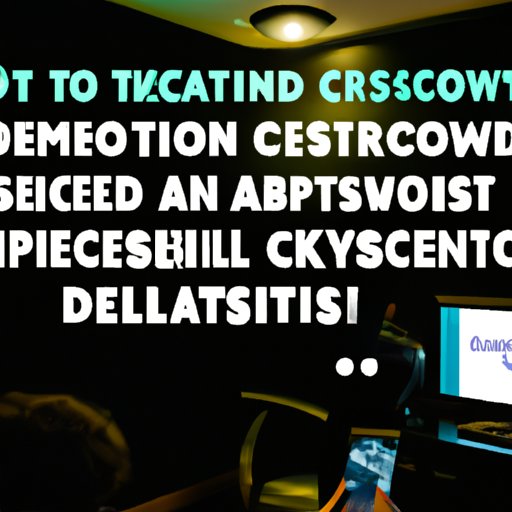Introduction
Open captioning in movie theaters has become increasingly popular in recent years, offering an accessible experience for audiences of all abilities. Open captioning refers to when captions are displayed onscreen during a movie, allowing viewers to read along and understand the dialogue without relying on audio. It’s a great way to make movies accessible to those who are deaf or hard of hearing, but also provides additional benefits to all viewers.
In this article, we’ll explore what open captioning is and how it makes going to the movies more accessible for everyone. We’ll look at how open captioning can improve the viewing experience for all moviegoers, as well as why it’s essential for deaf and hard of hearing audiences. Finally, we’ll discuss the impact of open captioning in cinemas and how it can lead to increased awareness and understanding.

How Open Captioning Makes Going to the Movies More Accessible
Open captioning can improve the movie-going experience for all viewers by making it easier to follow the dialogue and plot points. For people who are deaf or hard of hearing, open captioning can provide an invaluable service by making the movie more accessible. But there are many other benefits to open captioning that can benefit all viewers.
Improved Accessibility for Deaf and Hard of Hearing Audiences
For deaf and hard of hearing audiences, open captioning can be a lifesaver when it comes to enjoying films. Not only does it allow them to understand the dialogue without relying on audio, but it also offers the chance to experience movies in ways they may not have been able to before. Open captioning can help create a more inclusive and enjoyable experience for these viewers, allowing them to engage with films in the same way as their hearing peers.
Increased Understanding and Engagement for All Viewers
Open captioning can also benefit all viewers, regardless of their hearing ability. By displaying dialogue and plot points onscreen, open captioning can help viewers better understand and engage with the movie. This can be especially useful for viewers who may struggle to keep up with the dialogue, such as those who don’t speak the language in which the film is spoken or those who may have difficulty with the audio quality. Open captioning can also help viewers better appreciate the nuances of the story and characters, enhancing their overall viewing experience.

A Guide to Open Captioning for Moviegoers
If you’re interested in open captioned showings, there are a few things to keep in mind before heading to the cinema. Here’s a guide to open captioning for moviegoers:
Finding Open Captioned Showings
The first step is to find out if your local cinema offers open captioned showings. Many cinemas now offer open captioned screenings, so it’s worth checking with your local theater to see if they offer them. You can also check online for listings of open captioned showings in your area. Additionally, some streaming services and video-on-demand platforms also offer open captioned versions of films.
Preparing for an Open Captioned Movie Experience
Once you’ve found an open captioned showing, there are a few things you should do to prepare for the experience. First, it’s important to pay attention to the placement of the captions onscreen. Depending on the theater, the captions may be placed near the top, bottom, or center of the screen. Paying attention to this can help ensure you don’t miss any important dialogue or plot points.
It’s also helpful to arrive early to get used to the captions and adjust your seating accordingly. If you’re sitting too far away from the screen, you may miss some of the dialogue. Similarly, if you’re sitting too close, the captions may be difficult to read. Make sure to take note of the size and placement of the captions before settling into your seat.

Why Open Captioning is Essential for Deaf and Hard of Hearing Audiences
Open captioning is essential for deaf and hard of hearing audiences, as it allows them to access and enjoy movies in ways they may not have been able to before. Here are some of the benefits of open captioning for these audiences:
Improved Accessibility to Movies
Open captioning gives deaf and hard of hearing audiences the opportunity to experience movies in ways they may not have been able to before. Not only does it allow them to understand the dialogue without relying on audio, but it also helps create an inclusive and enjoyable experience for these viewers. With open captioning, deaf and hard of hearing audiences can engage with films in the same way as their hearing peers.
Improved Quality of Life
Open captioning can also improve the quality of life for deaf and hard of hearing audiences. By providing access to movies, open captioning can help reduce feelings of isolation and exclusion. It can also help create a sense of belonging, as deaf and hard of hearing viewers can share in the same experiences as their hearing peers.
Understanding the Impact of Open Captioning in Cinemas
Open captioning is having a positive impact in cinemas, leading to increased awareness and understanding of deaf and hard of hearing audiences. Here are some of the ways open captioning is making a difference:
Increased Awareness and Understanding
Open captioning is helping to increase awareness and understanding of deaf and hard of hearing audiences. By providing access to movies, open captioning can help educate viewers about the challenges faced by these audiences and foster greater empathy and understanding.
Improved Inclusion and Representation
Open captioning is also leading to improved inclusion and representation of deaf and hard of hearing audiences. By providing access to movies, open captioning can help give these audiences a platform to tell their stories and be represented onscreen. This can help create a more welcoming and inclusive environment for these viewers.
Conclusion
Open captioning in movie theaters can provide a number of benefits, from improved accessibility for deaf and hard of hearing audiences to increased understanding and engagement for all viewers. It’s essential for cinemas to offer open captioned showings to ensure that everyone can enjoy the same movie-going experience. Open captioning is making a positive impact in cinemas, leading to increased awareness and understanding of deaf and hard of hearing audiences and improved inclusion and representation.
(Note: Is this article not meeting your expectations? Do you have knowledge or insights to share? Unlock new opportunities and expand your reach by joining our authors team. Click Registration to join us and share your expertise with our readers.)
